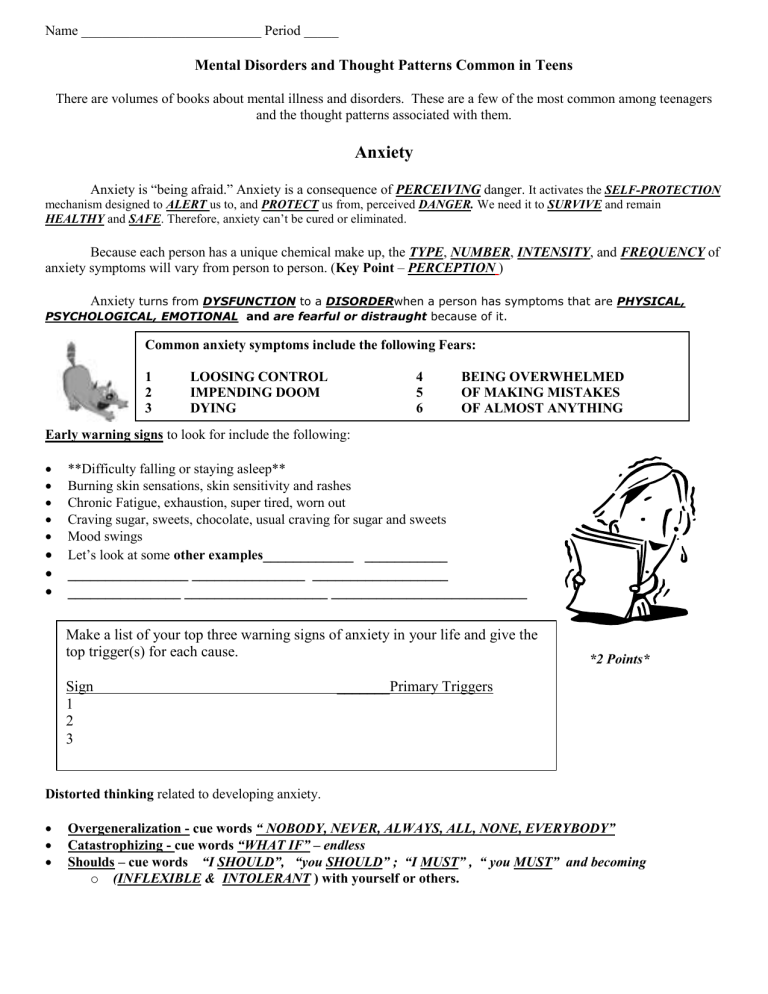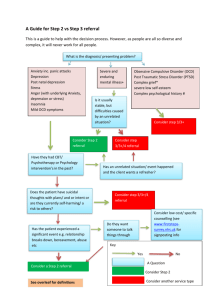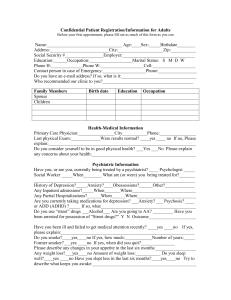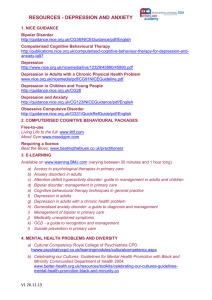Anxiety symptoms, anxiety attack symptoms:

Name __________________________ Period _____
Mental Disorders and Thought Patterns Common in Teens
There are volumes of books about mental illness and disorders. These are a few of the most common among teenagers and the thought patterns associated with them.
Anxiety
Anxiety is “being afraid.” Anxiety is a consequence of
PERCEIVING danger. It activates the SELF-PROTECTION mechanism designed to ALERT us to, and PROTECT us from, perceived DANGER.
We need it to SURVIVE and remain
HEALTHY and SAFE . Therefore, anxiety can’t be cured or eliminated.
Because each person has a unique chemical make up, the TYPE , NUMBER , INTENSITY , and FREQUENCY of anxiety symptoms will vary from person to person. ( Key Point – PERCEPTION )
Anxiety turns from DYSFUNCTION to a DISORDERwhen a person has symptoms that are PHYSICAL,
PSYCHOLOGICAL, EMOTIONAL and are fearful or distraught because of it.
Common anxiety symptoms include the following Fears:
1
2
LOOSING CONTROL
IMPENDING DOOM
4
5
BEING OVERWHELMED
OF MAKING MISTAKES
3 DYING
Early warning signs to look for include the following:
6 OF ALMOST ANYTHING
**Difficulty falling or staying asleep**
Burning skin sensations, skin sensitivity and rashes
>
Chronic Fatigue, exhaustion, super tired, worn out
>
Mood swings
Let’s look at some other examples ____________ ___________
________________ _______________ __________________
_______________ ___________________ __________________________
Make a list of your top three warning signs of anxiety in your life and give the top trigger(s) for each cause.
Sign
1
_______Primary Triggers
2
3
*2 Points*
Distorted thinking related to developing anxiety.
2 “ NOBODY, NEVER, ALWAYS, ALL, NONE, EVERYBODY”
Catastrophizing - cue words “WHAT IF” – endless
Shoulds – cue words “I SHOULD”, “you SHOULD” ; “I MUST” , “ you MUST” and becoming o (INFLEXIBLE & INTOLERANT ) with yourself or others.
Associated Mental illnesses/disorders from ANXIETY>>>LOOK LIKE
1.
2.
3.
4.
5.
GENERAL ANXIETY
OBSESSIVE COMPULSIVE
PHOBIAS
PANIC
POST-TRAMATIC STRESS
*3 Points*
Ex.:___________________________________________________
Ex.:___________________________________________________
Ex.:___________________________________________________
Ex.:___________________________________________________
Ex.:___________________________________________________
DISORDER
Anxiety may lead to deteriorating HEALTH and WELLNESS.
Anxiety can be resolved to LIMIT DISRUPTION in your life.
CHALLENGE your THOUGHTS and perception!!
Situational Depression/Clinical Depression
What is depression?
It’s impossible to escape life’s ups and downs. Feeling unhappy or sad in response to disappointment, loss, frustration or a medical condition is normal
. Many people use the word “depression” to explain these kinds of feelings, but that is really TEMPORARY PERMANENT , which is a normal reaction to events around us.
Discussion of circumstances (make list of 3 temporary OR permanent situations that could cause situational depression).
1 Point 1
2
3
Dysfunction vs. disorder? Key Point: CHOICE OF CONTINUED RESPONSE
CLINICAL DEPRESSION though, is OVERWHELMING and engulfs your day-to-day life , is INTENSE and
INTERFERS with your ability to work, study, eat, sleep, and have fun. It is UNRELENTING, with little if any relief.
Distorted thinking associated with depression.
Filtering- editing; MAGNIFYING to the NEGATIVE ; endless” editing out the positive
Catastrophizing - cue words “WHAT IF–
Global labeling – GENERALIZEone or two qualities into a NEGATIVE global JUDGMENT (stereotype)
THESE WOULD BE TYPICAL QUESTIONS TO BE CONSIDERED in answering…Are you clinically depressed?
If you identify with several of the following signs and symptoms, and they just won’t go away, you may be suffering from clinical depression.
you can’t sleep enough or you sleep too much
you can’t concentrate or find that previously easy tasks are now difficult
you feel worthless and hopeless
you have lost your appetite or you can’t stop eating
you are constantly irritated or become enraged even at small things – and this is new for you
you have UNCONTROLLED NEGATIVE THOUGHTS , no matter how much you try
WHAT TO DO - Ask for help and support
If even the thought of tackling your depression seems overwhelming, don’t panic. Feeling helpless and hopeless is a symptom of depression not the reality of your situation. It does not mean that you’re weak or you can’t change! The key to depression recovery is to start small and ASK FOR HELP.
Having a strong SUPPORT system in place will speed your recovery. Isolation fuels depression, so reach out to others, even when you feel like being alone. Let your FAMILY AND FRIENDS know what you’re going through and how they can support you.
Lifestyle changes are not always easy to make, but they can have a big impact on depression. Take a good look at YOURSELF and your own LIFESTYLE.
What changes could you make to support depression recovery? Self-help strategies that can be very effective include:
Make healthy lifestyle changes. KEY POINTS:
Cultivate SUPPORTIVE RELATIONSHIPS
Get regular EXERCISE and enough SLEEP (HMM-WHERE HAVE YOU HEARD THAT BEFORE?
Eat a healthy, mood-boosting diet ???________________________________________________________
Manage your STRESS and practice relaxation techniques
Challenge NEGATIVE thought patterns.
(Seek help immediately, when this happens>>) WHEN MOVING BEYOND SITUATIONAL
TO OTHER MORE EXTREME VERSIONS OF DEPRESSION
Associated Illnesses-
OF DEPRESSION
1. CLINICAL DEPRESSION
2. MANIC DEPRESSION
3. BI-POLAR
Seek professional help
If positive lifestyle changes and support from family and friends aren’t enough, seek help from a mental health professional to create a personalized treatment plan. Most plans include some form of therapy that gives you tools to treat depression from a variety of angles. What’s more, what you learn in therapy gives you skills and insight to help prevent depression from coming back.
Conduct Disorder/Disruptive Behavior Disorder -What are the signs of conduct disorder?
AGGRESSIVE behavior that harms or threatens other people or animals;
DESTRUCTIVE behavior that damages or destroys property;
Lying or theft; Truancy or other serious violations of rules;
Early tobacco, alcohol, and substance use and abuse; and precocious sexual activity.
Distorted thinking related to developing Conduct disorder
BLAMING– make someone else responsible for everything; you hold no responsibility for own choices
BEING RIGHT – makes you “HARD OF HEARING”, >>>also, lonely
Children with conduct disorder or oppositional defiant disorder also may experience:
Higher rates of DEPRESSION leading to other unhealthy choices, SUCH AS, _____________ ______________
ACADEMIC difficulties
Poor RELATIONSHIPS with peers or adults
Lifestyle choices related to:
Higher rates of INJURIES, school EXPULSIONS and problems with the law
Sexually transmitted DISEASES and ADDICTION.
Associated Personality Disorders-
PASSIVE AGGRESSION,
SCHIZOPHRENIA
Treatment is rarely brief since establishing new attitudes and behavior patterns takes time.
Some child and teen behaviors are HARD TO CHANGE after they have become ingrained.
Therefore, the earlier the conduct disorder is IDENTIFIED and treated, the better the chance for success.
EARLY TREATMENT offers a child a better chance for considerable improvement and hope for a more successful future.
Emotions Commotion ( 4 points)
Your mind and body reacting to thoughts and/or actual events (triggers) result in strong feelings called EMOTIONS.
What are your most difficult to manage emotions? Number them, in order of difficulty and place your most common triggers beside it. common triggers Emotion
Give one way in which you could manage your most difficult emotion in a healthier way for you and the people around you.
What happens when you deny your emotions?
What happens when your emotions are too overwhelming?







